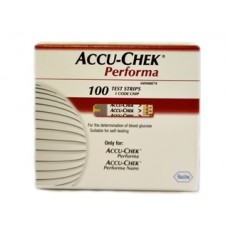ACCU-CHECK PERFORMA STRIP, PACK/100 (CHSACCPER)
- Brand: Pharmaceuticals
- Product Code: CHSACCPER
-
Ex GST: AU$58.54
GENERAL INFORMATION – DIABETES MONITORING
Test Strips
Test strips: A consumable element containing chemicals that react with glucose in the drop of blood is used for each measurement. For some models this element is a plastic test strip with a small spot impregnated with glucose oxidase and other components. Each strip is used once and then discarded. Instead of strips, some models use discs, drums, or cartridges that contain the consumable material for multiple tests.
Coding: Since test strips may vary from batch to batch, some models require the user to manually enter in a code found on the vial of test strips or on a chip that comes with the test strip. By entering the coding or chip into the glucose meter, the meter will be calibrated to that batch of test strips. However, if this process is carried out incorrectly, the meter reading can be up to 4 mmol/L (72 mg/dL) inaccurate. The implications of an incorrectly coded meter can be serious for patients actively managing their diabetes. This may place patients at increased risk of hypoglycemia. Alternatively, some test strips contain the code information in the strip; others have a microchip in the vial of strips that can be inserted into the meter. These last two methods reduce the possibility of user error. One manufacturer has standardized their test strips around a single code number, so that, once set, there is no need to further change the code in their older meters, and in some of their newer meters, there is no way to change the code.
Volume of blood sample: The size of the drop of blood needed by different models varies from 0.3 to 1 μl. (Older models required larger blood samples, usually defined as a "hanging drop" from the fingertip.) Smaller volume requirements reduce the frequency of unproductive pricks.
Diabetes and Self Monitoring
Diabetes is part of your everyday life. Appropriate self-monitoring can help you manage your daily blood glucose, and better adapt your lifestyle and treatment to suit your needs.
The more often you check your blood glucose, the better you will understand it and the easier it will be for you to manage your diabetes. It doesn’t matter if you have type 1 or type 2 diabetes, or if you are taking insulin or not, self-monitoring can help you and your doctor manage your therapy.
By managing your diabetes, you reduce the risk of developing complications. That means less eye, kidney and nerve damage, foot problems, and even stroke. Fewer complications means more time for you to enjoy your everyday life.
Self Monitoring of Blood Glucose Levles
Self-monitoring allows you to track the levels of (high or low) blood glucose in your body, how particular foods affect you, and what happens after physical activity or taking medication.
You might find self-monitoring even more helpful if you do this in a structured way – by monitoring at the right times and in the right situations e.g. either before food or two hours after.
self-monitoring can help you see a pattern that you and your doctor can use as part of your ongoing diabetes management.
Establish your Own Blood Glucose Chart
To have a clear idea of how your blood glucose changes throughout the day and why, you should try and self-monitor seven times a day, for three days in a row by using Accu-Chek blood glucose monitoring or other alternatives.
Testing before you eat will tell you about the effect your medication has on your blood glucose, while testing 2 hours after you eat tells you about the effect of your meal. In order to get a complete profile of your sugar level behaviour you should test before and after breakfast, before and after lunch, before and after dinner, and once before you go to bed. You can then compare each day and use it to better manage your diabetes.
By self-monitoring your blood glucose you can measure how your body handles different types of food, exercise, medication, stress and illness. Your blood glucose result may prompt you to eat a snack, take more insulin or go for a walk. Self-monitoring can also alert you to a blood glucose level that is too high or too low, which requires special treatment.
Controlling your blood glucose level is a very important part of managing diabetes. Regularly testing your blood glucose helps measure the effectiveness of your meal plan, physical activity and medications.
Alternate Sites Testing
Some blood glucose meters allow you to use blood samples from other parts of the body, such as the palm, forearm, upper arm, thigh or calf. Testing from alternate sites is not always ideal. Blood from your fingertip shows changes in blood glucose quickly, but blood from alternate sites may not, and you may not get the most accurate result. Always consult with your healthcare professional before using sites other than your fingertip for blood glucose testing.
Alternate site testing may be recommended when blood glucose is stable, such as immediately before a meal or before bedtime. AST is not recommended when blood glucose is changing quickly, such as immediately after a meal or after physical activity.
Never ignore symptoms of low or high blood glucose levels. If your blood glucose test result does not match the way you feel, perform a fingertip test to confirm the result.
Tags: AIMS Pharmacy, Pharmaceutical Preperations, Scheduled Poisons

